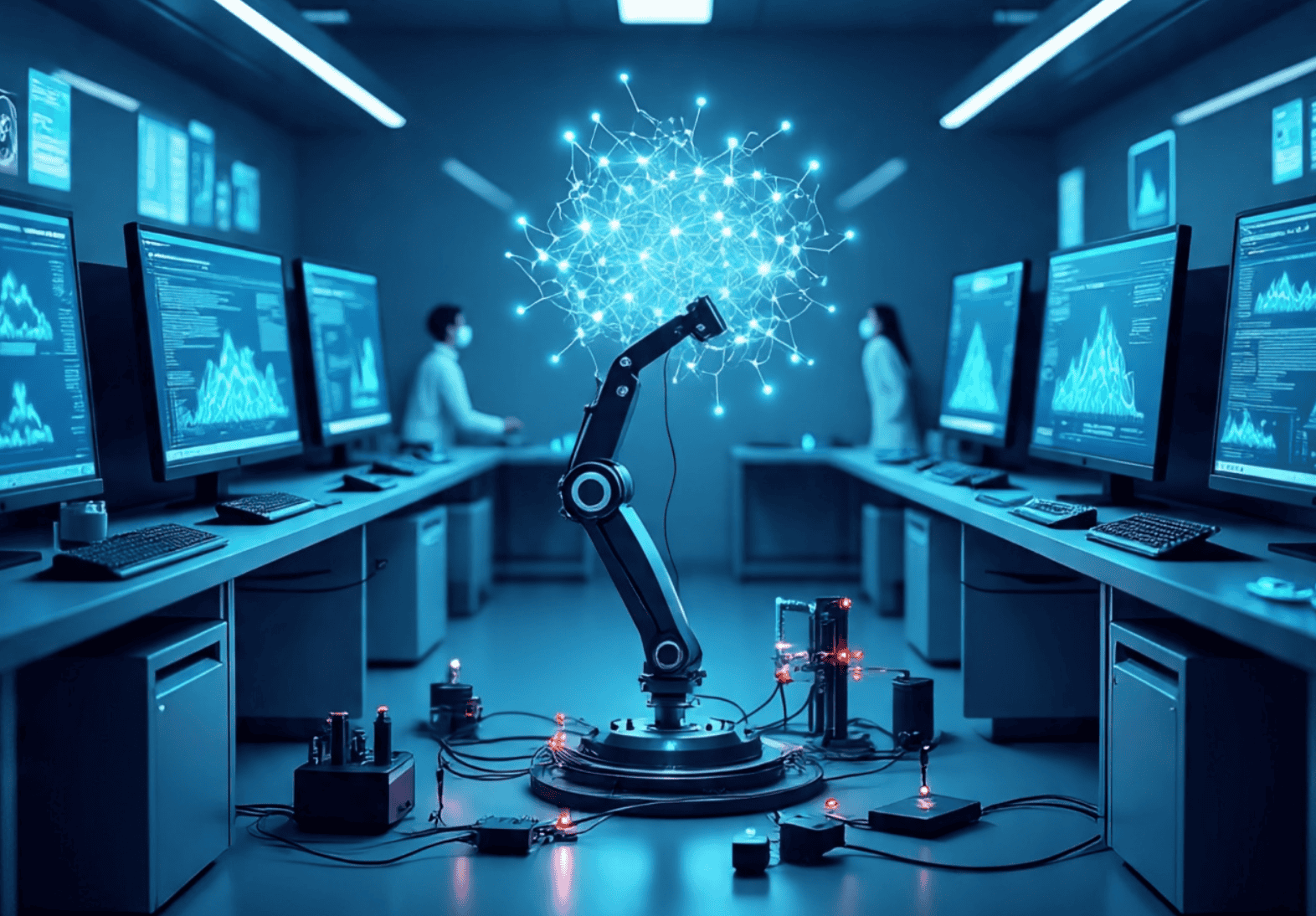Domain-Specific AI: Building Custom Agents for Industry Workflows

Ninety-five percent of companies now use generative AI, yet most implementations fall short of their potential. Domain-specific AI represents a fundamental shift from general-purpose models toward specialized agents designed for particular industries. According to Bain’s 2024 survey, 79% of organizations have already implemented AI agents [17]. However, only 1% of these implementations achieve maturity [17].
These specialized agents deliver precision, efficiency, and decision-making capabilities that general AI solutions cannot match [1]. Domain-specific AI learns to think like true experts, enabling enterprises to deploy tailored solutions for their unique business challenges [1]. Healthcare professionals use these agents to analyze medical images with diagnostic accuracy. Financial analysts deploy them to prevent fraud through pattern recognition in transaction data [1].
The business impact proves substantial. Organizations implementing domain-specific AI workflows can automate end-to-end processes securely, achieving up to 4x faster turnaround times while maximizing operational efficiency [18]. These agents create more flexible, efficient, and resilient systems that scale with business demands [1].
This blog post examines how to build custom AI agents for industry-specific workflows. We will explore their architecture, training methodologies, and real-world applications across key sectors. The analysis includes challenges and future developments shaping this field.
Limitations of General AI in Industry Workflows
General-purpose LLMs demonstrate remarkable abilities across broad tasks, yet they face substantial limitations when applied to industry-specific workflows. These constraints hinder effectiveness and create potential risks for businesses deploying AI without domain expertise enhancements.
Lack of domain-specific context in general LLMs
General-purpose language models excel at versatile tasks but stumble when confronted with specialized domains demanding expert knowledge. Their general-purpose nature significantly restricts effectiveness in domain-specific applications requiring specialized knowledge, such as healthcare, legal analysis, or chemistry [1]. This fundamental limitation necessitates knowledge injection techniques to bridge the gap between general language understanding and domain-specific demands.
Healthcare applications illustrate this challenge clearly. LLMs must comprehend medical terminologies, diagnoses, treatment plans, and drug interactions [1]. Without domain-specific training, these models struggle with complex medical concepts, potentially leading to dangerous misinterpretations. When general AI encounters legal or financial contexts without proper domain tuning, it typically produces overly generalized or inaccurate information [16].
General LLMs operate essentially as pattern-recognition systems rather than genuine knowledge repositories. They predict linguistic patterns without truly differentiating between factual accuracy and plausible-sounding text [16]. This limitation becomes particularly problematic in workflows where precision and expert judgment are non-negotiable.
Compliance and regulatory blind spots
Highly regulated industries face significant compliance risks from general AI solutions. The lack of industry-specific guardrails makes these models blind to crucial regulatory requirements and industry standards. A sobering example occurred when an attorney used ChatGPT for legal research, unknowingly submitting six fictitious case citations in a federal court case, resulting in a $5,000 sanction for acting in bad faith [16].
The challenge extends beyond simple factual errors. As noted in a Thomson Reuters report, 93% of professionals recognize the need for AI regulation, with 25% fearing compromised accuracy and 15% expressing data security concerns [2]. These blind spots create particularly acute risks in industries like healthcare, finance, and legal services, where non-compliance can trigger severe penalties.
Despite their computational power, general AI models often operate as “black boxes,” making decisions through opaque processes that regulatory frameworks struggle to address [19]. This opacity presents major obstacles for organizations striving to maintain accountability and comply with regulations requiring justification for automated decision-making processes.
Inaccurate interpretation of specialized data
General AI models frequently misinterpret specialized data, primarily because they’re trained on broad datasets rather than domain-specific information. A particularly concerning manifestation of this limitation is “hallucination” – when AI convincingly presents false information as factual [16]. In specialized domains, these hallucinations can have serious consequences.
The quality of data fundamentally impacts AI performance. As the saying goes – “garbage in, garbage out” – if the data used to train an AI model contains flaws, the system produces equally flawed results [17]. This principle becomes especially problematic in specialized domains where data quality standards are exceptionally high.
Consider medical imaging interpretation, where general AI models demonstrate inherent biases, particularly regarding gender and ethnicity, potentially misrepresenting critical diagnoses [20]. Similarly, in financial applications, flawed AI-driven analysis might lead to poor investment decisions or regulatory non-compliance, exposing firms to financial losses and legal scrutiny [16].
To overcome these limitations, domain-specific AI agents must be developed with:
- Expert-curated training data specific to the industry
- Integration with verified knowledge bases
- Continuous validation against industry standards
- Transparent decision-making processes that align with regulatory requirements
Core Architecture of Domain-Specific AI Agents
Building effective domain-specific AI requires sophisticated architecture that differs significantly from general-purpose systems. This architecture contains specialized components working in harmony to deliver industry-relevant results.
Role of the reasoning engine in task orchestration
The reasoning engine functions as the “brain” of domain-specific AI agents, operating like a conductor for an orchestra. It first understands user intent, then decomposes problems into logical mini-tasks, and finally routes these tasks to appropriate specialized agents [8]. This orchestration framework enables the AI to seamlessly integrate with APIs, databases, and other AI applications [9].
The reasoning engine supports four core aspects of agency: intentionality (planning), forethought, self-reactiveness, and self-reflectiveness [10]. These elements provide the autonomy needed for AI agents to set goals, create plans, monitor performance, and reflect on outcomes to achieve specific objectives.
When a request lacks clarity, the reasoning engine doesn’t proceed blindly. Instead, it engages with users for clarification when details are missing or contradictory information appears [8]. This proactive dialog ensures the system fully understands requests before proceeding.
Task decomposition and agent specialization
Task decomposition represents a critical architectural strategy where complex problems are broken into smaller, manageable subtasks. This approach enhances the model’s ability to process intricate instructions by simplifying them into sequential steps [11].
The benefits of effective task decomposition include:
- Enhanced performance through precise handling of subtasks
- Error reduction by simplifying complex tasks into manageable units
- Efficient resource utilization and improved scalability
- Improved training processes focusing on specialized functions [11]
Task decomposition follows a structured process: identifying the complex task, segmenting it into subtasks, arranging these in logical sequence, executing subtasks (often in parallel where possible), and finally integrating outcomes [11].
This approach allows for delegating specific subtasks to smaller, specialized models rather than relying on a single large model. Organizations implementing “agentic workflows” with multiple fine-tuned smaller LLMs instead of a single large one can achieve 70%–90% cost reductions [11].
Integration with domain expert knowledge bases
Domain-specific AI must integrate expert knowledge to be truly effective in specialized environments. This integration occurs through various techniques including knowledge graphs, ontologies, and specialized APIs [12].
Knowledge graphs allow agents to understand relationships between different data points, making responses more accurate and informed. By embedding structured, interconnected formats of supplier relationships, regulatory constraints, and risk dependencies, AI systems can validate predictions against domain-specific rules rather than relying purely on statistical correlations [13].
Domain experts play a crucial role in this process by connecting the technical aspects of AI systems with real-life usage and value. They help assess data completeness, identifying blind spots that purely data-driven approaches might miss [13]. Additionally, experts can guide the creation of high-quality training data, refine industry terminology to prevent misinterpretations, and align AI reasoning with business logic [13].
The integration of domain expertise transforms domain-specific AI from pattern-recognition systems into genuine knowledge repositories that can make informed decisions within their specialized context.
Training and Fine-Tuning for Industry-Specific Tasks
Training data quality determines the success of domain-specific AI implementations. According to recent surveys, 87% of people believe companies should be transparent about how they source data for generative AI models [14]. The training and fine-tuning process transforms general models into specialized domain experts capable of handling industry-specific tasks with precision.
Using expert-curated datasets for model accuracy
Expert-curated datasets deliver dramatic improvements in model accuracy for specialized domains. Human annotators with subject matter expertise validate and enhance training data quality [15]. Medical image annotation provides a clear example: radiologists identify and label abnormalities in X-rays and MRIs, training AI systems to detect diseases with higher precision [15].
Articul8 exemplifies this approach by transforming general Llama models into domain specialists through rigorous fine-tuning with reasoning trajectories and curated benchmarks [16]. Their implementation processed 50,000 documents into 1.2 million images, 360,000 tables, and 250,000 summaries, creating a knowledge graph exceeding 11 million entities [16].
Expert involvement ensures datasets reflect diverse perspectives, reducing bias and aligning more closely with real-world scenarios. TELUS Digital works with Ph.D. researchers, professors, and industry professionals to create high-quality STEM datasets [14].
Fine-tuning with internal enterprise data
Internal enterprise data provides unique value for fine-tuning domain-specific AI agents. Organizations can:
- Adapt existing models to specific business contexts
- Integrate proprietary knowledge and terminology
- Enhance performance on specialized tasks
- Maintain data privacy and security
Fine-tuning significantly reduces infrastructure investment while improving relevance [1]. Training from scratch costs between $50-100 million for models like GPT-4 [17], making fine-tuning the more practical approach. Organizations typically structure their training data as prompt-completion pairs in formats like JSONL documents [18].
Parameter-efficient fine-tuning (PEFT) techniques such as low-rank adaptation (LoRA) minimize computational resources by introducing a small number of trainable parameters instead of updating the entire model [1]. This approach makes domain adaptation accessible without massive computing resources.
Balancing general and specialized LLMs
Finding the optimal balance between general language capabilities and domain expertise remains crucial. Articul8 achieves this by using Meta’s Llama family as a flexible foundation that’s subsequently specialized through domain-specific training [16]. Their domain-specific models offer twofold better accuracy and completeness compared to general-purpose models, at a fraction of the cost [16].
The methodology involves carefully blending in-domain and general-purpose data during fine-tuning [2]. Custom LLMs start with general-purpose models and are fine-tuned with proprietary data, combining broad capabilities with specialized accuracy [19].
“Catastrophic forgetting” occurs when new knowledge partially overwrites existing capabilities during fine-tuning [17]. Organizations must carefully curate domain-specific data relevant to their use case while preserving general language understanding.
Successful training of domain-specific AI requires balancing breadth and depth. Organizations must use the foundation of general models while injecting the specialized knowledge that makes AI truly valuable for industry-specific workflows.
Real-World Applications Across Key Industries
Domain-specific AI delivers concrete results across industries where general AI models fall short. These specialized implementations demonstrate measurable improvements in efficiency, accuracy, and operational performance.
Healthcare: Diagnostic support and patient triage
Healthcare AI systems now detect abnormalities in medical images with accuracy rivaling human experts across radiology, dermatology, pathology, and cardiology [20]. Johns Hopkins implemented an AI triage tool that integrates with patient digital health records, enabling nurses to assess incoming patients more efficiently and improve patient flow [21]. The system provides triage recommendations within seconds and has expanded to multiple hospitals across different states [21]. Machine learning models consistently outperform conventional triage systems, reducing mistriage rates to 0.9% compared to 1.2% with traditional methods [22].
Finance: Fraud detection and risk modeling
Financial institutions deploy domain-specific AI for real-time fraud detection through transaction pattern analysis and suspicious activity flagging. JP Morgan reported lower fraud levels, better customer experiences, and fewer false positives after implementing their AI detection system [23]. PayPal achieved a 10% improvement in real-time fraud detection through AI systems operating worldwide around the clock [4]. These systems enhance risk management through predictive analytics that estimate future transactions and recognize unusual patterns indicating potential fraud attempts [4].
Manufacturing: Predictive maintenance and quality assurance
AI-powered predictive maintenance analyzes sensor data from machinery to forecast failures before they occur. The International Society of Automation reports that factories typically lose between 5-20% of manufacturing capacity due to equipment failure [5]. AI monitoring reduces downtime by up to 15% [5]. BMW reduced defect rates by 30% within a year of implementing AI vision systems for quality control [24].
Legal: Contract analysis and compliance checks
Legal teams traditionally spend an average of 3.2 hours reviewing a single contract, according to a 2024 survey [25]. Domain-specific AI streamlines these processes significantly. Orangetheory Fitness used AI tools to automate the redlining process for over 1,000 different membership agreement templates, reducing project time from six months to three [26].
Customer Service: Context-aware AI workflows
Context-aware AI systems analyze customer data in real-time to intelligently route requests, surface relevant information, and automate routine tasks [27]. AI-powered chatbots provide 24/7 support while reducing operational costs and maintaining personalized interactions [27]. These systems monitor tone, language, and behavioral cues to assess customer sentiment instantly, allowing appropriate adjustments in service delivery [28].
Challenges and Future of Domain-Specific AI
Organizations implementing domain-specific AI face significant hurdles that must be addressed to unlock the technology’s full potential. Connecting to the right data and systems remains the most cited challenge in deploying AI agents [29].
Data privacy and security in sensitive domains
Protecting sensitive information represents a non-negotiable priority, particularly in regulated industries. The statistics reveal concerning gaps: 60% of businesses adopting AI fail to develop ethical AI policies, while 74% of firms neglect addressing potential biases [7]. Organizations handling domain-specific data must navigate complex privacy regulations including GDPR, HIPAA, and CCPA [3].
Effective security measures require specific protocols:
- Data minimization (collecting only necessary information)
- Strong encryption and access controls
- Continuous monitoring and regular audits
- Incident retrospectives after any issues [30]
The “black box” problem—where AI decision-making lacks transparency—presents another security challenge. This opacity combines with the risk of adversarial attacks that could compromise model integrity [31].
Scalability of agentic systems across departments
Without centralized control, fragmented tools, data, and responsibilities create chaos across organizational departments [29]. Scaling domain-specific AI agents requires standardized integration approaches and credential management systems. Traditional security methods often break down when multiple agents access sensitive APIs [32].
A notable paradox emerges in cost structures. Training costs for large language models remain extraordinarily expensive, while inference costs decrease rapidly [33]. This divergence creates opportunities for organizations to deploy specialized AI at scale once development hurdles are overcome.
Emerging trends: Multimodal AI and agent marketplaces
Domain-specific AI is evolving toward multimodal capabilities—systems that can hear commands and see the world alongside users [34]. This progression represents a natural extension of specialized AI into more sophisticated interaction patterns.
The security implications remain significant. By 2027, over 40% of AI-related data breaches will stem from improper use of generative AI across borders [35]. Organizations must prepare for these emerging risks while capturing the benefits of advanced AI capabilities.
Agent-to-agent (A2A) communication represents another development. Google and dozens of partners recently announced the A2A protocol, enabling AI agents built by different vendors to communicate and coordinate actions securely [6]. By 2030, universal agent standards will allow specialized agents to work together seamlessly, creating powerful multi-agent workflows that dynamically combine to solve complex problems [6].
The implications for domain-specific AI are substantial. These developments suggest a future where specialized agents collaborate across organizational boundaries while maintaining their domain expertise.
Conclusion
Domain-specific AI represents a fundamental shift in how organizations approach industry-specific challenges. The evidence presented demonstrates that specialized agents deliver precision and efficiency that general AI solutions cannot achieve.
General-purpose LLMs face substantial limitations when confronted with specialized domains requiring expert knowledge. Organizations must therefore build custom AI agents with robust architectures featuring reasoning engines, task decomposition capabilities, and seamless integration with domain knowledge bases.
Training methodologies prove critical for developing effective industry-specific AI. Expert-curated datasets significantly enhance model accuracy, while fine-tuning with internal enterprise data allows organizations to adapt existing models to their unique business contexts. The optimal balance between general language capabilities and specialized knowledge remains essential for performance.
Real-world applications confirm the substantial impact of domain-specific AI across key industries. Healthcare facilities deploy AI for diagnostic support and patient triage. Financial institutions implement specialized systems for fraud detection and risk modeling. Manufacturing companies use predictive maintenance solutions that reduce downtime. Legal teams streamline contract analysis processes, while customer service departments create context-aware workflows.
Challenges exist in this implementation journey. Data privacy concerns require careful navigation, particularly in sensitive domains. Scalability issues across departments demand standardized approaches. However, emerging trends like multimodal AI and agent marketplaces point toward significant future developments.
Organizations implementing domain-specific AI workflows gain substantial benefits—from automating end-to-end processes securely to creating more flexible, efficient systems that scale with business demands. Understanding both the architecture and applications of these specialized AI agents becomes essential as we move toward a future where AI thinks more like true industry experts rather than general-purpose assistants.
The shift from general to domain-specific AI represents more than technological advancement; it represents a maturation of artificial intelligence into truly useful business tools. Organizations that recognize this transition and invest in custom AI solutions tailored to their specific industry needs will gain significant competitive advantages through improved accuracy, reduced costs, and enhanced operational efficiency.
Key Takeaways
Domain-specific AI agents are revolutionizing industries by delivering precision and efficiency that general-purpose AI cannot match, with 79% of organizations already implementing AI solutions.
• General AI falls short in specialized domains – Lacks industry context, creates compliance risks, and misinterprets specialized data, making domain-specific training essential.
• Architecture matters for success – Effective domain AI requires reasoning engines for task orchestration, specialized agent decomposition, and integration with expert knowledge bases.
• Expert-curated training delivers superior results – Using domain-specific datasets and fine-tuning with internal enterprise data achieves 2x better accuracy at fraction of general model costs.
• Real-world impact spans all industries – From healthcare diagnostic support to financial fraud detection, manufacturing predictive maintenance, and legal contract analysis, specialized AI reduces costs and improves outcomes.
• Future trends point to multimodal capabilities – Agent-to-agent communication protocols and universal standards will enable seamless collaboration between specialized AI agents by 2030.
The shift from general to domain-specific AI represents a fundamental evolution in how businesses leverage artificial intelligence. Organizations that invest in custom AI agents tailored to their industry workflows will gain significant competitive advantages through improved accuracy, reduced costs, and enhanced operational efficiency.
References
[1] – https://towardsdatascience.com/a-developers-guide-to-building-scalable-ai-workflows-vs-agents/
[2] – https://www.labellerr.com/blog/domain-specific-agents/
[3] – https://aisera.com/blog/domain-specific-ai-agents/
[4] – https://www.multimodal.dev/post/building-ai-agents
[5] – https://arxiv.org/html/2502.10708v1
[6] – https://kili-technology.com/large-language-models-llms/building-domain-specific-llms-examples-and-techniques
[7] – https://www.linkedin.com/pulse/understanding-addressing-inaccurate-misleading-outputs-death-zyure
[8] – https://legal.thomsonreuters.com/blog/navigate-ethical-and-regulatory-issues-of-using-ai/
[9] – https://www.wipfli.com/insights/articles/ra-navigating-data-compliance-in-the-age-of-ai-challenges-and-opportunities
[10] – https://lumenalta.com/insights/ai-limitations-what-artificial-intelligence-can-t-do
[11] – https://www.sciencedirect.com/science/article/pii/S0001299824000461
[12] – https://www.ibm.com/think/tutorials/llm-agent-orchestration-with-langchain-and-granite
[13] – https://www.ibm.com/think/topics/agentic-architecture
[14] – https://www.allaboutai.com/ai-glossary/task-decomposition/
[15] – https://www.linkedin.com/pulse/developing-custom-ai-agents-techniques-best-practices-abstrabit-cwmnc
[16] – https://medium.com/data-science/injecting-domain-expertise-into-your-ai-system-792febff48f0
[17] – https://www.telusdigital.com/about/newsroom/telus-digital-launches-expert-curated-off-the-shelf-datasets?linkname=telus_digital_launches_expert_curated_off_the_shelf_datasets&linktype=newsroom
[18] – https://sigma.ai/golden-datasets/
[19] – https://aws.amazon.com/blogs/machine-learning/accelerating-articul8s-domain-specific-model-development-with-amazon-sagemaker-hyperpod/
[20] – https://www.databricks.com/glossary/fine-tuning
[21] – https://www.velvetech.com/blog/llms-vs-slms/
[22] – https://www.itmagination.com/blog/fine-tuning-ai-models
[23] – https://arxiv.org/abs/2310.04945
[24] – https://lilt.com/blog/overview-general-purpose-vs-purpose-built-vs-custom-llms
[25] – https://pmc.ncbi.nlm.nih.gov/articles/PMC8285156/
[26] – https://www.hopkinsmedicine.org/news/articles/2022/11/tool-developed-to-assist-with-triage-in-the-emergency-department
[27] – https://pmc.ncbi.nlm.nih.gov/articles/PMC11158416/
[28] – https://trustpair.com/blog/ai-for-fraud-detection-the-complete-guide/
[29] – https://www.ibm.com/think/topics/ai-fraud-detection-in-banking
[30] – https://www.oracle.com/scm/ai-predictive-maintenance/
[31] – https://www.revgenpartners.com/insight-posts/ai-powered-quality-control-in-manufacturing-a-game-changer/
[32] – https://www.legalontech.com/ai-contract-review-software
[33] – https://ironcladapp.com/journal/legal-ai/harnessing-ai-for-contract-analysis/
[34] – https://www.salesforce.com/service/ai/customer-service-ai/
[35] – https://www.talkdesk.com/blog/ai-customer-service/
[36] – https://blog.dataiku.com/scaling-ai-agents-with-dataiku
[37] – https://www.iamdave.ai/blog/domain-specific-ai-models-explained-the-future-of-business-ai/
[38] – https://rtslabs.com/gen-ai-with-domain-specific-data
[39] – https://aisera.com/blog/scaling-agentic-ai/
[40] – https://www.harvardmagazine.com/2025/03/artificial-intelligence-vulnerabilities-harvard-yaron-singer
[41] – https://deepsense.ai/blog/standardizing-ai-agent-integration-how-to-build-scalable-secure-and-maintainable-multi-agent-systems-with-anthropics-mcp/
[42] – https://lfnetworking.org/ai-trends-and-how-to-efficiently-build-domain-specific-ai-with-open-source-software/
[43] – https://www.salesforce.com/blog/future-of-ai-agents/
[44] – https://www.paloaltonetworks.com/cyberpedia/generative-ai-security-risks
[45] – https://futureforce.ai/content/future-of-ai-agent-marketplaces/










